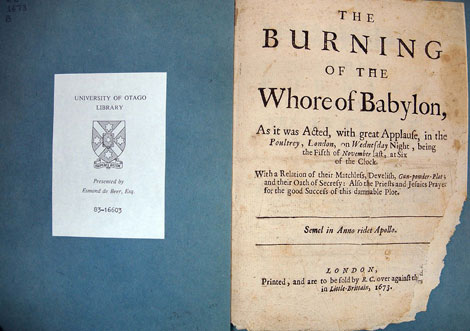Footnotes on Official History: Celebrating Dr Hocken’s Pamphlet Collection

On 31 March 1910, Lord Plunket officiated at the opening of the Hocken Wing, a purpose-built structure at the Otago Museum designed to house Dr Thomas Morland Hocken’s collection of some 4,300 printed books and pamphlets, as well as a large number of photographs, manuscripts, maps, drawings and paintings. While many items were already in situ, the occasion signalled the physical transfer of Dr Hocken’s collection, deemed one of the best in the Dominion. As is well known, Hocken was too ill to attend the opening ceremony; he died 17 May 1910, aged 74.
Among the treasures transferred to the Hocken Wing were some 2,800 pamphlets, bound into 218 thick, separately titled volumes. A pamphlet is defined as a short piece of polemical writing, intended for wide circulation, printed and issued as an unbound publication, with either stapled or sewn pages (Glaister, 2001). George Orwell was a little more expansive: ‘Probably a true pamphlet will always be somewhere between 500 and 10,000 words, and it will always be unbound and obtainable for a few pence. A pamphlet is never written primarily to give entertainment or to make money. It is written because there is something that one wants to say now, and because one believes there is no other way of getting a hearing.’ Orwell added that ‘the great function of the pamphlet is to act as a sort of footnote or marginal comment on official history.’ An ever-increasing number of pamphlets have tumbled off the press from a wide variety of organisations, institutions, and individuals. The range is enormous, from Conservatives, Socialists, Communists, and Anarchists, through to vegetarians, anti-vivisectionists, pro- decimalization advocates, and literary squibbers. Indeed, it is hard to count the growing number of ranting works by quacks and the quirky.
This full spectrum was available to Hocken, yet he steeled himself against the in-coming tide. Like the serious collector that he was, he remained focussed on his own personal collecting interests such as the New Zealand Company, Otago and Southern settlements, Maori and Polynesian histories, and travels, including emigration guides. There was little deviation. Other New Zealand-based collectors such as Sir George Grey, Justice Chapman, Alexander Turnbull, Downie Stewart and Robert MacNab were seduced by these ephemeral publications and in cases collected on a wider scope. Their pamphlet collections are now institutionalized (Auckland City Libraries; University of Otago; Turnbull Library; Dunedin Public Library).
There are good pamphlets and there are bad ones. Many fall into the latter category; now unreadable, with some bordering on the illegal or scurrilous. Yet they remain a phenomenon, rising and falling in popularity and usage over the years as trends of censorship, writing, causes and their subsequent propaganda, and the press dictate.
Footnotes on Official History: Celebrating Dr Hocken’s Pamphlet Collection not only marks Dr Hocken’s gift to the University 100 years ago, but also highlights a lesser known but highly used component of his collection. Disregarding Thomas Bodley’s famous interdiction that pamphlets were ‘not worth the custody in suche a Librarie’, Dr Hocken saved them, and by this attached an intrinsic value to them beyond their own time and place. Their significance is twofold: as a cumulative collection, they add to the store of intellectual knowledge in New Zealand, and they remain important relics of well-established print culture tradition.
